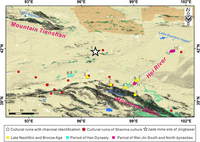Shanma culture
| Geographical range | Gansu, China |
|---|---|
| Dates | 1000-200 BCE[1] |
| Major sites | Gudongtan, Zhaojiashuimo |
| Preceded by | Majiayao culture (2,300–2,000 BCE)[2] Qijia culture (2,200–1,600 BCE)[2] |
| Followed by | Shajing culture (800–200 BCE)[2] Han dynasty (202 BCE–220 CE)[2] |
The Shanma culture (Ch: 骟马文化) was an ancient culture in the Hexi corridor from 1000 to 200 BCE. It succeeded the Siba culture (1,600–1,300 BCE) in the area, and preceded the Shajing culture (800–200 BCE), and the expansion of the Han dynasty (202 BCE–220 CE) in the region.[2]
The area of the Shanma culture is broadly identical with that of the preceding Siba culture. It corresponds to the western area of the Hexi corridor and Inner Mongolia, from Yangguan in the west to Yumen in the east, with the Shajing culture not far beyond to the southeast.[3]
The Shanma culture is known to have used jade, from the Hanxia deposit, and later from the Mazongshan deposit, or from the Jingbaoer jade mine in the Mazong Mountain (Mazong Shan).[4][5]
The Shanmas had agricultural activities and grew barley, wheat, and millets. But their livestock indicate a tendency towards nomadic pastoralism, as they had animals better suited for long-distance travel such as dogs, ovicaprids, horses, cattle, and camels, but they had no pigs.[5]
The Shanma culture may have been associated with the Wusun tribes of Chinese history.[6]
-
Distribution of reported nephrite deposits and the sites where jadewares were excavated in Northeast Asia
-
Shanma ceramic vessel, Jingbaoer mine
-
Jingbaoer jade mine in the Mazong Mountain (Mazong Shan)
-
Jade ore from the Jingbaoer mine
References[edit]
- ^ Liu, Fengwen; Yang, Yishi; Chen, Guoke; Zhang, Shanjia; Zhang, Hucai (21 April 2021). "Changes in Wood Utilization Due to Iron Age Jade Mining in the Western Hexi Corridor: Wood Charcoal Investigations". Frontiers in Earth Science. 9. doi:10.3389/feart.2021.636534.
- ^ a b c d e f g Li, Xin; Wei, Wenyu; Ma, Minmin; Lu, Minxia; Du, Linyao; Yang, Yishi; Chen, Guoke; Ren, Lele (2023). "Transformation of animal utilization strategies from the late Neolithic to the Han Dynasty in the Hexi Corridor, northwest China: Zooarchaeological and stable isotopic evidence". Frontiers in Earth Science. 10. doi:10.3389/feart.2022.1064803. ISSN 2296-6463.
- ^ Linduff, Katheryn M.; Sun, Yan; Cao, Wei; Liu, Yuanqing (23 November 2017). "Ancient China and its Eurasian Neighbors: Artifacts, Identity and Death in the Frontier, 3000–700 BCE": 190. doi:10.1017/9781108290555.005.
Another post-Siba bronze culture – the Shanma – is located in the western Hexi Corridor and Inner Mongolia, between Yumen in the east, Yangguan in the west and Qilian in the south and along the Huahai section of the Great Wall in the north. The Shanma cultural remains roughly overlap with the distribution area of the Siba culture.
{{cite journal}}: Cite journal requires|journal=(help) - ^ Wang, Rong; Shi, Xiaowei (2022). "Progress on the nephrite sources of jade artifacts in ancient China from the perspective of isotopes". Frontiers in Earth Science. 10. doi:10.3389/feart.2022.1008387. ISSN 2296-6463.
- ^ a b Liu, Fengwen; Yang, Yishi; Chen, Guoke; Zhang, Shanjia; Zhang, Hucai (21 April 2021). "Changes in Wood Utilization Due to Iron Age Jade Mining in the Western Hexi Corridor: Wood Charcoal Investigations". Frontiers in Earth Science. 9. doi:10.3389/feart.2021.636534.
During the Iron Age, the Shanma culture (ca. 1000–100 BCE) occupied the western Hexi Corridor (Xie, 2002). Archeobotanical evidence suggests this culture was still engaged in crop cultivation, with barley, wheat, and millets forming the basis of their subsistence (Yang, 2017). Carbonized remains of these crops were also recovered from the JBR site (Yang, 2017). However, the faunal composition and strategies for feeding livestock in the Shanma culture were obviously oriented toward mobile pastoralism. Zooarcheological evidence reveals that dogs, ovicaprids, horses, cattle, and camels were maintained by the Shanma people, but with the notable absence of pigs (Yang et al., 2019). Livestock better suited as long-distance transport animals were widely used by the Iron Age inhabitants of the western Hexi Corridor, as recorded in historical texts such as the Shiji (Records of the Grand Historian) and Hanshu (Book of Han or History of the Former Han). Shanma culture artifacts unearthed at JBR indicate that the miners there may have also relied on agropastoral subsistence.
- ^ Liu, Jinbao (25 March 2022). The General Theory of Dunhuang Studies. Springer Nature. pp. 7–8. ISBN 978-981-16-9073-0.






